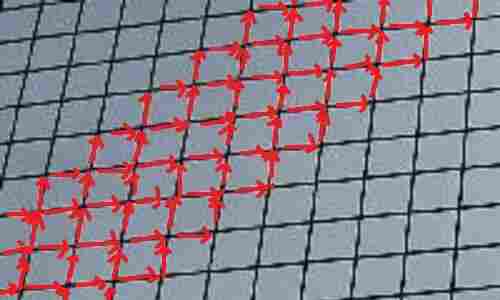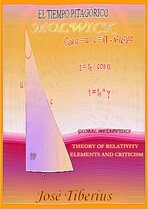2.c.4.b) Characteristics and nature of light
In the previous section, we have seen the nature of light from its reality or material support and its relations with mass and kinetic energy.
Now we will complete the nature of light with an analysis of its characteristics concerning movement. Let us note that knowing the nature of light explained in the previous paragraph is necessary to understand the characteristics of propagation of light.
It refers to the characteristics of light about its velocity, derived from the fact that gravity field –LUM Aether (Luminiferous, universal, and mobile) or tension of longitudinal curvature of the filaments of the Global Aether– is the supporting medium upon which the transverse mechanical waves of electromagnetic energy propagate.
The book Physics and Global Dynamics studies the behavior and characteristics of light regarding movement.
These characteristics of light can group in the two following points:
-
The tension of reticular structure of matter as a support medium for light
Light travels in vacuum without a need for a support medium, by Relativistic Physics and Quantum Mechanics.
As we have seen in the book Global Mechanics, one of the characteristics of electromagnetic energy is that it is a transverse mechanical wave upon the tension of the Global Aether or reticular structure of matter.
The characteristics of light due to its supporting medium, and directly related to its velocity are the following:
Constant velocity
In Einstein’s Relativity Theory, the speed of light is constant in vacuum, as a mathematical axiom or theoretical postulate.
In Global Dynamics, the speed of light is constant provided the medium upon which it travels does not change, and neither are any of the characteristics that influence the velocity of the transverse mechanical waves.
The gravity field is considered the supporting medium of light, and it is a non-dispersive medium. Consequently, if the tension of the longitudinal curvature of filaments, which generates the gravitational potential energy, alters, then the speed of light will change.
Maximum velocity
In Einstein’s theory, the speed of light in vacuum is the maximum speed, as an axiom or theoretical postulate.
As we have seen, in Global Dynamics, the speed of light is variable and, among others, as a function of gravitational potential energy.
Moreover, it is not maximum as it is additive with the velocity of its supporting medium.
Additive speed of light regarding its natural reference system
The behavior of light has a special inertia when analyzed from an external point to its natural frame of reference. For us, this natural or privileged frame of reference is usually the Earth.
Given that, humans are a bit Earth-centered, and that all initial experiments carried out on Earth, the idea of non-inertial nature of light was suitable. By the characteristic of inertia, we mean in the sense that the speed of light it is added to the velocity of its natural reference frame.
Moreover, we say special inertia characteristic, because the speed of light is only additive when measured from outside, because inside its natural reference system it is always the same one, provided the properties of its supporting medium not alter. Light behaves on Earth like the drag of a snake on the wagon of a train, or on the sand on the ground, with the same speed in every direction!
The snake on the wagon only goes faster in one direction than in another when measuring its speed from the ground –or another planet!
ESA –before was NASA– has scheduled the LISA experiment to try to detect gravitational waves in space. To do this, it will send three spacecraft into space and carry out an interferometry experiment similar to the Michelson-Morley one. The experiment will ultimately confirm the above section, thereby putting an end to Einstein’s Theory of Relativity.
Among others, the above experiment allows Global Physics to be a scientific theory, as it proposes the experimental verification of its affirmations. The book Scientific Experiments in Global Physics explains in detail the Distant Michelson-Morley experiment. It is identical to the LISA experiment, initially projected by NASA.
LUM Aether Photon propagation 
Light and Newton Law of Gravitation
The propagation of light changes not only by its supporting medium but also by the support medium’s characteristics.
We have just seen that the speed of light is neither constant nor maximum; now we will see purely gravitational effects on the propagation of light.
One must not confuse this effect of the gravity field on light speed with the curvature effect explained by the book Law of Global Gravity. The latter explains in depth why it affects light double than mass.
Let us see the following natural phenomena:
The curvature of light by stars
Einstein’s Relativity Physics explains the phenomenon of curvature of light with a contraction or expansion of space due to a geometric effect of the continuum, named gravity.
The book of the Global Law of Gravity affirms in its section about Energy Experiments that this natural phenomenon of curvature of curvature of light and that of gravitational redshift are the same physical phenomenon. The double curvature concerning the hypothetical effect in Newton’s Law of Gravitation is due to the second component of the atractis causa or Merlin effect, also explained in the said book.
The book of the Global Law of Gravity affirms in its section about Energy Experiments that this natural phenomenon of curvature of light and that of gravitational redshift are the same physical phenomenon. The double curvature with respect to the hypothetical effect in Newton Law of Gravitation is due to the second component of the atractis causa or Merlin effect, also explained in said book.
Gravitational redshift
Einstein’s theory explains the characteristic of the gravitational redshift with a temporal dilation.
The section Gravitational redshift of light of the book Global Law of Gravity explains this natural phenomenon with a change in tension of the longitudinal curvature of the filaments of Global Aether. In particular, the result of the interplay of forces and energies of the supporting medium is additive to light’s energy, due to the exchange of internal energy produced.
